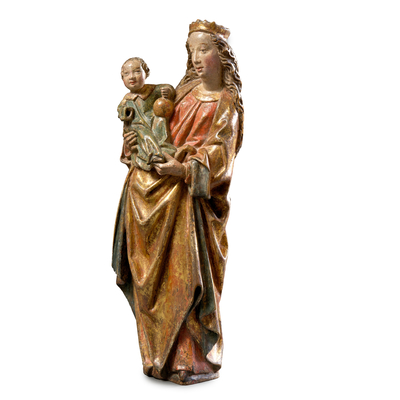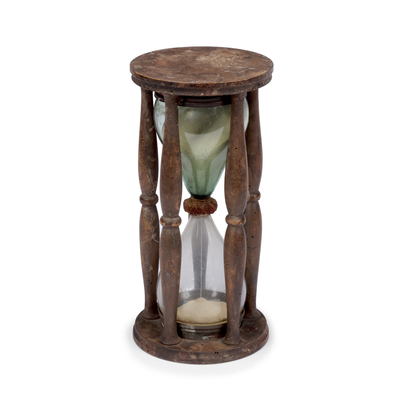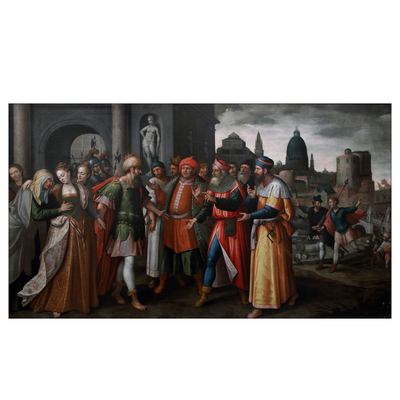Siegburg Schnelle
Global shipping available
- Origin
- Siegburg
- Period
- Ca. 1570 - 1590
- Material
- Stoneware, pewter
- Height
- 19.5 cm
- Diameter
- 7.6 cm
- Literature
H. Gansohr, ‘Die Siegburger schnellen’ in: E. Hähnel (ed.), Siegburger Steinzeug, Keulen 1987, cat. no. 375, 383, 443, pp. 53 - 62.
E. Klinge, Duits steengoed, Zwolle 1996, cat. no. 12, p. 34, 35.
G. Reineking von Bock, Steinzeug, Keulen 1986, cat. no. 197, 198, p. 204.
Questions about this object?
Please use one of the contact options below:
Description
This richly decorated stoneware jug was made in Siegburg and is a so-called 'schnelle'. These schnelles are characterised by their slender, high and slightly conical shape, with decorated sides in relief between the three lower and three upper bands. They were used as drinking vessels. The cream-coloured, unglazed stoneware is typical of the Siegburg stoneware production, which was widely exported via the Hanseatic League. The jug is decorated with three applied vertical reliefs consisting of three panels. The reliefs depict three women: Judith with a sword in her right hand and the head of Holofernes in her left, Lucretia committing suicide with a sword and a personification of Faith with a cross in her left hand and a cup in her right hand. The women wear richly decorated contemporary clothing. The upper part of the reliefs consists of floral motifs with an angel and a mascaron under an arch. Below the women are three coats of arms: the coat of arms of the union of Gulik-Kleef-Berg, the coat of arms of the archbishopric of Cologne (specifically of Archbishop Salentin von Isenburg) and the city coat of arms of Cologne. The arms are held respectively by two lions, two naked figures and two seated men. The jug is fitted with a flattened pewter lid with the monogram W on the inside.
The three women belong to the virtuous women who were frequently depicted as a series in the Renaissance. On a number of schnelles the combination Judith and Lucretia appears, often together with Esther. The stoneware schnelles were developed in Cologne in the second quarter of the 16th century and were soon produced in Siegburg. The earliest known dated Siegburger schnelle is from 1559. Many schnelles were also produced in Raeren.
The waterproof and hard stoneware was used from the 13th century onwards as drinking utensils and for storing liquids. Around 1500, it became fashionable to decorate the stoneware, which was mainly produced in Cologne, Frechen, Siegburg, Raeren, and Westerwald, with applied reliefs. The different regions developed their own styles, although some mutual influence can be demonstrated. The refined reliefs, which were as it were pasted onto the object after a first drying, were mostly inspired by contemporary engravings. Many of the motifs can be traced back to the work of Virgil Solis, Heinrich Aldergrever and Theodor de Bry. In the third part of the sixteenth century, new decoration techniques, such as stamping and incised motifs, were introduced.
See Reineking von Bock (cat. no. 197) for very similar floral motifs and Klinge (cat. no. 12) for a similar Judith figure: both schnelles monogrammed 'LW', an as yet unknown maker working in Siegburg around 1570 - 1580. There are further similarities with a schnelle in the collection of Museum Lüeneburg and a sherd in the collection of Museum Huis van Hilde (inv. no. 9390-11). See also a print by Charles Onghena in ‘Objects Rare recueillis et publiés par Joan. D’Huyvetter, P.F. Goesin-Verhaeghe, Gent 1829’, collection Rijksmuseum Amsterdam (inv. no.BI-B-FM-034-11).








